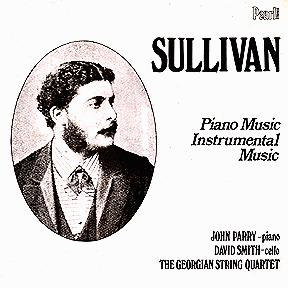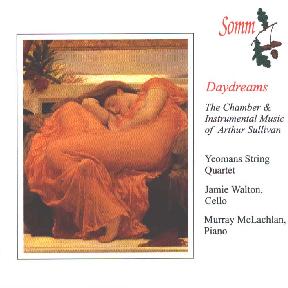Discography of Sir Arthur Sullivan:
Chamber and Solo Instrumental Music
Sullivan's career as a composer of solo instrumental and chamber music was not a distinguished one. All his works in the genre are school pieces or date from very early in his professional career. By all accounts, Sullivan was at best an average pianist, and none of his solo piano works is especially great, but most have the flush of melodic inspiration that nearly always makes the composer's music at least attractive.
The compser's brother Frederic, best known as creator of Apollo in Thespis and the Judge in Trial by Jury, was a evidently a capable cellist, which would explain why all of Sullivan's chamber music involves the cello somehow.
None of this music has been often recorded. The 1974 LP Sullivan: Instrumental Music (described below) included all of the surviving items known at that time. The 1980s cassette If Doughty Deeds included three of the piano solo works: Thoughts, Day Dreams, and Twilight.
A CD titled Daydreams includes most of the items from the 1974 LP (one of them had been misattributed to Sullivan), plus most importantly the String Quartet that until the mid-1990s was thought to be lost.
A brief description of all the works is immediately below.
- Scherzo, Capriccio No. 1, piano solo, 1857; MS.
- Capriccio No. 2, piano solo, unfinished, 1857; MS.
- These are both evidently juvenile works dating from his Leipzig student days. Neither has been recorded.
- String Quartet in D minor, perf. Leipzig, May 1859.
- Romance in G minor, string quartet, 1859; pub. 1964.
- String quartets were an obligatory exercise for virtually all composers. There is hardly a significant composer who did not write at least one. Sullivan's first effort in the form does not survive, but the second he sent home from school as a gift to his mother. It is a short but delightful work.
- Thoughts, Op.2, piano solo; pub. Cramer, 1862.
- Allegretto con grazia, ded. to Lindsay Sloper (later published as "Reverie" for violin and piano).
- Allegro grazioso, ded. to Miss Dunville (later published as "Melody" for violin and piano).
- An Idyll, cello and piano, 1865; pub. in bazaar souvenir, 1899.
- Arthur Jacobs notes that this piece was published in a souvenir book of the Charing Cross Hospital Bazaar at Royal Albert Hall, 21-22 June 1899. The book had contributions from 39 authors and 9 composers. Sullivan's Idyll appears on pp. 181-5, with a facsimile of the composer's signature.
- Allegro risoluto, piano solo; pub. 1976.
- Day Dreams, six pieces for solo piano; pub. Boosey, 1867.
- Andante religioso
- Allegretto grazioso
- Andante
- Tempo di Valse (Felicita Valse)
- Andante con molto tenerezza (Elle et Lui)
- A l'Hongroise, Allegretto
While Sullivan and George Grove were in Vienna searching for Schubert's Rosamunde, Sullivan was asked by a fellow musician he met there to play one of his own pieces, and this was the one he picked. The Musical Times later said that the work displayed a "graceful elegance of style."
- Duo concertante, cello and piano; pub. Lamborn, Cock, 1868.
- Dedicated to Brinley Richards. This piece and the Idyll are the only two works for cello and piano that survive, but it is likely that there were many others that Arthur wrote for his brother Fred.
- Twilight, piano solo; pub. Chappell, 1868.
- Dedicated to Miss Rachel Scott Russell
Sullivan: Instrumental Music
John Parry, piano
David Smith, cello
The Georgian String Quartet
 Pearl SHE-512 |
This ambitious album put on disc all of Sullivan's surviving chamber and solo instrumental works (at least as known in 1974). I do not find any of the music particularly memorable, but it is perhaps indicative of the potential Sullivan showed in the serious vein he chose ultimately not to pursue.
The Princess of Wales March appears to be a piano reduction of the orchestral march Sullivan wrote for the marriage of the Prince of Wales. The "Fugue in B-Flat" is not shown in the List of Works in Jacobs's appendix, and the liner notes of the record give no indication of where it came from. Stephen Turnbull explained:
The fugue in B flat is not by Sullivan. It is by Thomas Attwood, an exercise by him in writing in the style of Mozart. It was given to Sullivan at the RAM as a copying exercise (this apparently was standard practice), hence a ms in his hand. Those responsible for the Pearl LP accepted it at its face value, for which, in the early 70s, I guess they could be forgiven.
The contents are as follows:
| Side 1 | Side 2 |
|---|---|
|
|
| Date | Label | Format | Number |
|---|---|---|---|
| 1974 | Pearl | Stereo LP | SHE 512 |
Daydreams: The Chamber &
Instrumental Music of Arthur Sullivan
Yeomans String Quartet
Jamie Walton,, cello
Murray McLachlan, piano
 SOMM SOMMCD 233 |
Most of the music on this CD was previously available only on a long out-of-print 1974 Pearl LP (see above) that, like this recording, presented all of Sullivan's surviving chamber and solo piano music. (He most likely wrote a good deal more such music in his youth that does not survive.)
Since then, a one-movement string quartet from his Leipzig days (1858) has been discovered. At 11:38, it is the most substantial work on the new CD. For the work of a boy of 16, it is a remarkably assured piece, and certainly it shows that Sullivan could have excelled in this genre, had he chosen to pursue it. His only other work for string quartet, written just a year later, is a three-minute romance.
The cello figures in three other pieces, "An Idyll" (1865), the meatier "Duo Concertante," Op. 2 (1868), and a Berthold Tours arrangement of "Slowly, slowly" from The Golden Legend.
Lastly, there are a number of solo piano pieces, including the six "Daydreams" (1867) and the two pieces called "Thoughts," No. 1 & 2 (1862). Another, labeled "Berceuse," is Sullivan's own arrangement of the lullaby from Cox and Box. As the notes observe, "the transformation is extraordinary. Far more than a piano reduction of the song, it is really a lyrical fantasia, in which an utterly different mood is superimposed." And finally, there are the Allegro Risoluto (1866) and "Twilight" (1868), a short piano piece dedicated to his then lover, Rachel Scott Russell.
Virtually all of this music dates from before Sullivan's association with W. S. Gilbert. Once he discovered his felicity for stage music, he abandoned chamber and solo piano music, although the accompaniments to his many songs show that he was a skilled composer for the piano. Most of the music on this CD is not recognizable as Sullivan, though it is none the worse for that.
The items are arranged in alternating styles and moods, as perhaps they would be in a concert. It makes for a soothing, if not very challenging, sixty-four minutes of enjoyment. This does mean, however, that the items are out of chronological order. Even the six Daydreams are split up on the disc.
Contents are as follows:
- String Quartet
- Daydreams No. 1
- Daydreams No. 2
- An Idyll
- Allegro Risoluto
- Daydreams No. 3
- Daydreams No. 4
- Slowly, Slowly
- Daydreams No. 5
- Daydreams No. 6
- Berceuse
- Romance for String Quartet
- Thoughts No. 1
- Thoughts No. 2
- Twilight
- Duo Concertante, Op. 2
| Date | Label | Format | Number |
|---|---|---|---|
| 2002 | SOMM | CD | SOMMCD 233 |
